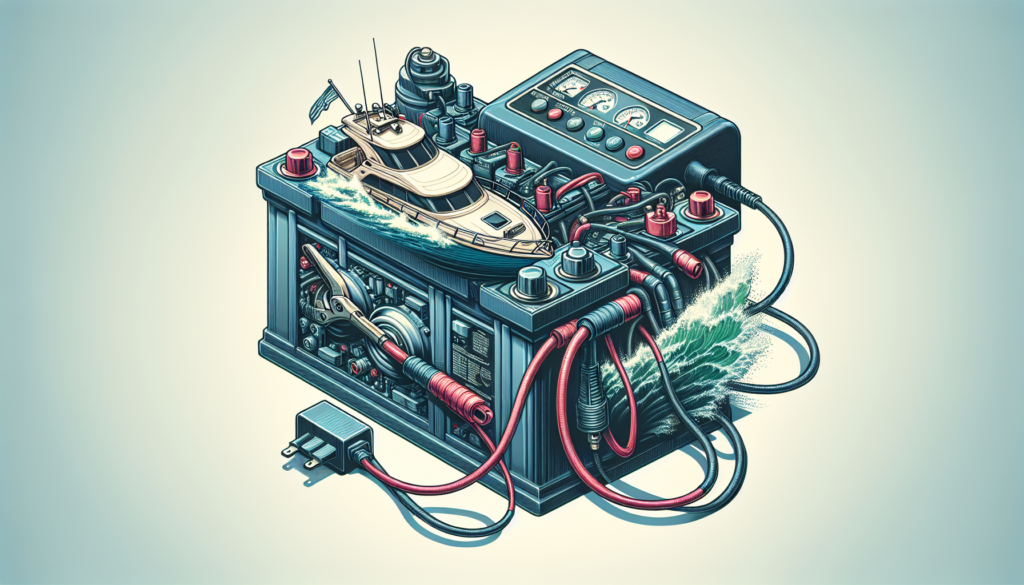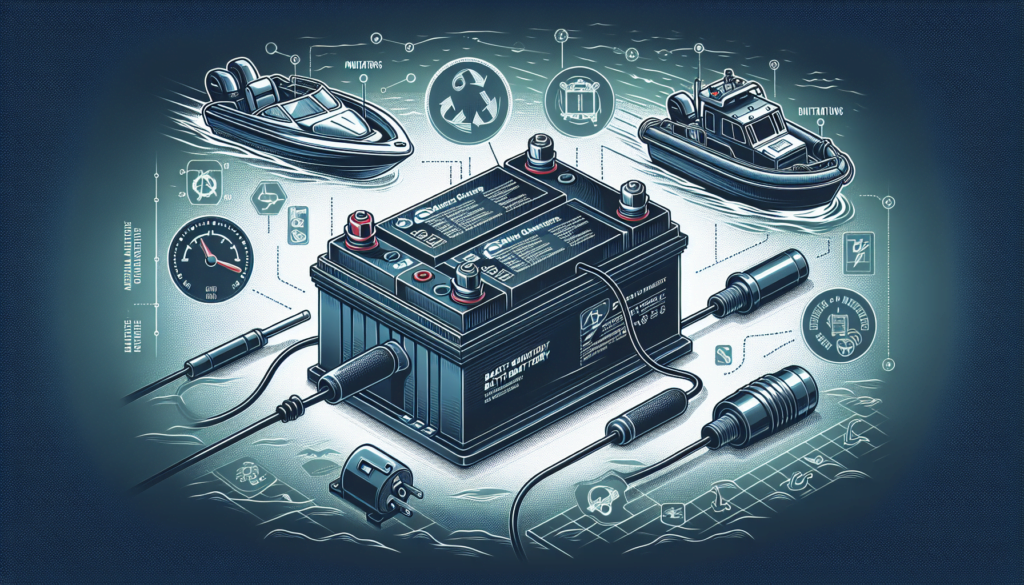Just picture this: you’ve planned a lovely day out on the water, only to find your boat’s engine battery dead. A real bummer, isn’t it? That’s where the “Quick Guide To Boat Engine Battery Maintenance” comes in handy. In this guide, you’ll find everything you need to know about keeping your boat’s engine battery in its optimum condition. The guide covers crucial aspects like regular inspections, cleaning procedures, and proper storage methods to extend the lifetime of your battery. Armed with this knowledge, sudden battery failures will become a thing of the past and magnificent days out on the water await you.
Understanding Boat Engine Batteries
A boat engine battery is an indispensable component of any marine engine system. It’s what provides the spark needed to start the engine and powers all the essential accessories on the vessel. Understanding the basics of boat engine batteries, such as types, functions, and need for routine maintenance, can go a long way in enhancing the performance and longevity of your boat.
Types of Boat Engine Batteries
There are mainly three types of boat engine batteries – flooded lead-acid batteries, absorbed glass mat (AGM) batteries, and gel cell batteries. Flooded batteries are the most traditional type and require regularly checking and refilling the water level. On the other hand, AGM and gel cell batteries are maintenance-free options and offer deep cycle capabilities and faster recharge times – just at a higher cost.
How Boat Engine Batteries Work
Boat engine batteries convert chemical energy into electrical energy through a process known as galvanic reaction. This reaction occurs in a battery cell, involving an anode (negative terminal), cathode (positive terminal), and an electrolyte (a substance facilitating the flow of electrons). When a load (like a starter motor) is connected, electrons flow from the anode to cathode, creating an electric current.
Importance of Regular Maintenance
Regular maintenance of boat engine batteries extends their lifespans and ensures optimal performance. Maintenance tasks may include checking and refilling water levels, regular charging, cleaning terminals, and regular checks for signs of wear and tear. Ignoring regular maintenance can lead to battery failure, leaving you stranded on the water or without power for essential boat functions.
Assessing Battery Health
Maintaining battery health is crucial for the efficient functioning of a boat engine. Here are ways to ascertain the health of your boat engine battery.
Visual Inspection of the Battery
Inspect the battery regularly for any signs of damage. This could include cracked casing, bulging sides, corrosion on the terminals, or leaking acid. Any of these indicators could hint at a serious internal problem requiring immediate attention or battery replacement.
Checking Battery Voltage
Battery voltage check is an accurate method to determine a battery’s state of charge. A multimeter can be used for this purpose. Remember, a fully charged 12V battery should display a reading close to 12.6V when the engine is off.
When to Replace Your Battery
Typically, a well-maintained boat battery lasts about 4-5 years. However, if you notice a consistent drop in voltage, difficulty in starting the engine, or need to refill water frequently in flooded batteries, it may be time to replace your battery.

Safe Battery Handling Practices
Practicing safe handling of boat batteries can prevent accidents and extend battery life.
Proper Battery Installation
Ensure the battery is installed in a clean, dry, and ventilated compartment. Always connect the positive terminal first and then the negative. Misplacing these connections can damage the electrical system.
Hazards of Incorrect Handling
Incorrect handling of batteries could lead to acid spills, explosion, electric shocks, or irreparable damage to the boat’s electric system. Always handle them with care, especially when charging or handling battery acid.
Protective Gear for Battery Maintenance
When working with batteries, wear protective gear like rubber gloves, eye protection, and an apron. If you accidentally get battery acid on your skin or eyes, rinse immediately with cold water and seek medical help.
Routine Battery Cleaning
Maintaining a clean battery not only improves its efficiency but also extends its longevity.
Cleaning the Battery Casing
Use a diluted baking soda solution and a brush to scrub the battery casing clean of dirt, grime, and minor acid spills. Rinse with water and dry it completely.
Removing Corrosion from Battery Terminals
A mix of baking soda and water can also be applied to battery terminals to remove corrosion. Using a wire brush, scrub gently until the terminals are clean.
Safety Measures During Cleaning
While cleaning, never allow the soda solution to enter battery vents as it can neutralize the acid inside. Also, always disconnect the battery before starting the cleaning process.

Checking and Maintaining Battery Water Levels
Water level maintenance is key for flooded lead-acid batteries.
Understanding Battery Water Levels
The water inside a battery reacts with lead plates to create an electric charge. Over time, the water dissipates and needs to be refilled to continue the process.
How to Check Water Levels
Water levels can be checked by removing the battery caps. The water should just touch the bottom of the refill hole, or about half an inch above the metal plates.
Adding Distilled Water to the Battery
If water levels are low, added distilled water until the proper level is reached. Tap or purified water should not be used as it contains minerals and impurities that can interfere with battery chemistry.
Proper Battery Charging Techniques
Charging a battery properly ensures its longevity and optimal performance.
Choosing the Right Battery Charger
Different batteries require different chargers. For instance, flooded batteries need a charger with an algorithm for constant current charging, while AGM batteries require a more complex algorithm.
Correct Charging Procedure
Always follow the manufacturer’s guidelines when charging the battery. Generally, it involves connecting the charger to the battery first, then plugging the charger into a power source.
Avoiding Overcharging
Avoid overcharging the battery as it can lead to premature wear and tear or even battery failure. Using a smart charger that automatically stops charging once the battery is full can prevent overcharging.
Winter Battery Maintenance
Boat batteries require special care during winters.
Preparing the Battery for Winter Storage
Before storing the battery for winter, clean it, ensure it’s fully charged, and disconnect it from the boat to prevent power drains.
Battery Storage Locations
Store the battery in a cool, dry, and well-ventilated place. Unlike car batteries, boat batteries can be stored on concrete floors.
Recharging the Battery After Winter
After storage, recharge the battery before installation. Even in storage, batteries lose some of their charge; recharging will ensure they are ready to go when you are.
Switching and Isolating Batteries
Switching and isolating batteries is an essential practice, especially on boats with more than one battery.
Why Isolate Boat Batteries
Isolation prevents the accidental discharge of the starting battery when using the house battery and vice versa. It also allows one battery to be charged while the other is in use.
How to Switch Between Batteries
Battery selector switches are used to switch between batteries. Follow manufacturer’s guidelines for correctly using the switch.
Proper Isolation Techniques
Use battery isolators or automatic charging relays for effective isolation. Make sure only to operate these devices with the engine off.
Dealing with Dead or Weak Batteries
At some point, your boat battery might show signs of weakness or might die. Here’s what you can do in such situations.
Detecting a Dead or Weak Battery
A multimeter can help detect dead or weak batteries. A reading below 12.2V indicates a discharged battery, while a reading below 10.5V indicates a dead battery.
Options for Restoring Battery Power
For weak batteries, try trickle charging. This slow charging method can help recover some of the battery strength. For dead batteries, a jump start might give short term power, but replacement is typically necessary.
When to Get a New Battery
Consider getting a new battery when regular maintenance no longer helps in maintaining the charge, or when the battery is over five years old.
Troubleshooting Battery Problems
Identifying and addressing battery problems can prevent costly replacements.
Common Battery Issues
Common issues include not holding a charge, swelling, leaking, or the boat not starting despite the battery being fully charged.
How to Identify Battery Problems
Regular inspection and voltage checks can help identify most battery problems. Also, keep an eye out for any visible signs of damage.
Professional Help for Battery Troubles
If you’re unable to diagnose or fix the problem, it’s best to consult a professional. A trained technician can diagnose the problem accurately and suggest appropriate solutions.


[…] Inspect the boat battery for any corrosion, loose wires, or damaged connectors. Establish that it is adequately charged to carry out its functions. […]